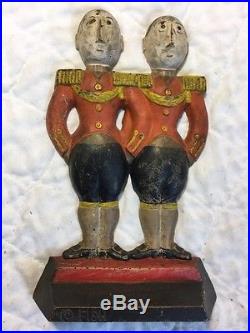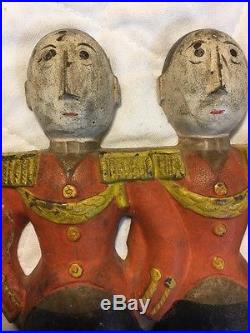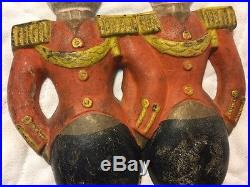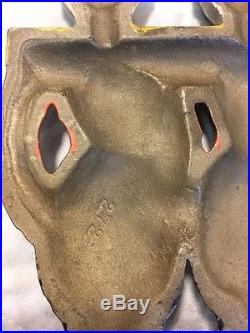












Antique Cast Iron Art Deco Doorstop Hubley Footmen Anne Fish Fine Original Paint. This is the smaller version of the 2 Hubley made. The same doors is shown on page 213 of The Doorstop Encyclopedia by Smith as shown in our 11th photo and a scan of the actual Hubley catalog from the 1930’s shown in my last photo. No cracks or chips, all paint is original with minor wear only. The Fish series is among the most desirable doorstops of all, some have been reproduced recently but the Footmen was never reproduced. Absolutely guaranteed genuine authentic original Hubley 1930’s. Perhaps the only things more welcoming than open doors are the brightly colored cast-iron door stops holding them ajar. Like the best collectibles, these seemingly indestructible household objects are as visually appealing as they are practical, adding a bit of charm and whimsy to any home. Door stops first appeared in England in the late 1700s. Made of cast brass, they were used to help prop open the heavy English doors, allowing air to better circulate through homes. The earliest door stops had wooden handles so they could be easily moved. Handles disappeared in the 19th century; by then, cast iron had replaced brass. Most door stops youll find today were likely made in America sometime between the turn of the last century and 1940. They hit their peak of popularity during the 1920s and 30s. It is hard to determine the age of a door stop simply by its design, as some of the most popular styles were manufactured for decades. Motifs were numerous: rose-covered cottages, ships, lighthouses, windmills, covered wagons, trains, baskets of flowers or fruit, ladies in fine dress, children, gnomes, holiday and fairy-tale figures, cats, dogs, cartoon characters, and more. Nearly all examples featured brightly colored enamel paint. Manufacturers included Hubley in Lancaster, Pennsylvania; Bradley & Hubbard in Meriden, Connecticut; Wilton Products Inc. In Wrightsville, Pennsylvania; Albany Foundry in Albany, New York; and A. Greenblatt Studios in Boston. Most makers ceased production with the onset of World War II, but not all: John Wright Co. In Wrightsville, Pennsylvania, now reproduces some of the original Hubley patterns. Though age is not the determining factor in assessing the value of a door stop, a reproduction of an earlier pattern is worth a fraction of the price of the original. Condition, paint surface, and rarity of the design are very important to collectors. Rust and repainting can drastically affect values. The best advice for determining whether a door stop is truly vintage, not reproduction, is to examine the surface closely. Does the wear look inconsistent with use? Is the paint too shiny? Run your hand over ita real vintage door stop will feel smooth, whereas a reproduction will have a rough, sandy surface. Also, seams on reproductions are often mismatched, and pieces are sometimes painted on the back side. Original manufactures never were. Anne Fish (1890 – 1964). Anne Harriet Fish was active/lived in New York / United Kingdom. Anne Fish is known for Illustration, figure, genre painting. Anne Harriet Fish (Sefton) was born in Bristol, England. She worked in oil, watercolor and was an illustrator who was active in London, Sussex and St. She married Walter Sefton in 1918. In New York City, she did illustrations for “Vanity Fair” and “Vogue” including the cover for “Vanity Fair” in April, 1917. Around the time of the First World War porcelain doll heads were no longer available from Germany, and so Fulper Pottery makers of Flemington, New Jersey, among others, made some. This was a new clay body for them as their regular line of pottery was made from stoneware clay. She is well known for a line of Art Deco doorstops she designed for Hubley in the 1930s. The item “Antique Cast Iron Art Deco Doorstop Hubley Footmen Anne Fish Fine Original Paint” is in sale since Sunday, December 04, 2016. This item is in the category “Antiques\Decorative Arts\Metalware”. The seller is “spooknook” and is located in Weymouth, Massachusetts. This item can be shipped worldwide.
- Type: Doorstops
- Primary Material: Cast Iron
- Style: Art Deco
